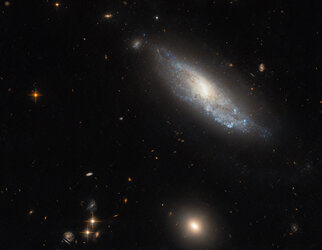Accept all cookies Accept only essential cookies See our Cookie Notice

About ESA
The European Space Agency (ESA) is Europe’s gateway to space. Its mission is to shape the development of Europe’s space capability and ensure that investment in space continues to deliver benefits to the citizens of Europe and the world.
Highlights
ESA - United space in Europe
This is ESA ESA facts Member States & Cooperating States Funding Director General Top management For Member State Delegations European vision European Space Policy ESA & EU Space Councils Responsibility & Sustainability Annual Report Calendar of meetings Corporate newsEstablishments & sites
ESA Headquarters ESA ESTEC ESA ESOC ESA ESRIN ESA EAC ESA ESAC Europe's Spaceport ESA ESEC ESA ECSAT Brussels Office Washington OfficeWorking with ESA
Business with ESA ESA Commercialisation Gateway Law at ESA Careers Cyber resilience at ESA IT at ESA Newsroom Partnerships Merchandising Licence Education Open Space Innovation Platform Integrity and Reporting Administrative Tribunal Health and SafetyMore about ESA
History ESA Historical Archives Exhibitions Publications Art & Culture ESA Merchandise Kids Diversity ESA Brand Centre ESA ChampionsLatest
Space in Member States
Find out more about space activities in our 23 Member States, and understand how ESA works together with their national agencies, institutions and organisations.
Science & Exploration
Exploring our Solar System and unlocking the secrets of the Universe
Go to topicAstronauts
Missions
Juice Euclid Webb Solar Orbiter BepiColombo Gaia ExoMars Cheops Exoplanet missions More missionsActivities
International Space Station Orion service module Gateway Concordia Caves & Pangaea BenefitsLatest
Space Safety
Protecting life and infrastructure on Earth and in orbit
Go to topicAsteroids
Asteroids and Planetary Defence Asteroid danger explained Flyeye telescope: asteroid detection Hera mission: asteroid deflection Near-Earth Object Coordination CentreSpace junk
About space debris Space debris by the numbers Space Environment Report In space refuelling, refurbishing and removingSafety from space
Clean Space ecodesign Zero Debris Technologies Space for Earth Supporting Sustainable DevelopmentLatest
Applications
Using space to benefit citizens and meet future challenges on Earth
Go to topicObserving the Earth
Observing the Earth Future EO Copernicus Meteorology Space for our climate Satellite missionsCommercialisation
ESA Commercialisation Gateway Open Space Innovation Platform Business Incubation ESA Space SolutionsLatest
Enabling & Support
Making space accessible and developing the technologies for the future
Go to topicBuilding missions
Space Engineering and Technology Test centre Laboratories Concurrent Design Facility Preparing for the future Shaping the Future Discovery and Preparation Advanced Concepts TeamSpace transportation
Space Transportation Ariane Vega Space Rider Future space transportation Boost! Europe's Spaceport Launches from Europe's Spaceport from 2012
Galactic isolation
Thank you for liking
You have already liked this page, you can only like it once!
The swirls of the galaxy IC 1776 stand in splendid isolation in this image from the NASA/ESA Hubble Space Telescope. This galaxy lies over 150 million light-years from Earth in the constellation Pisces.
IC 1776 recently played host to a catastrophically violent explosion — a supernova — which was discovered in 2015 by the Lick Observatory Supernova Search, a robotic telescope which scours the night sky in search of transient phenomena such as supernovae. A network of automatic robotic telescopes are spread across the globe, operated by both professional and amateur astronomers, and, without human intervention, reveal short-lived astronomical phenomena such as wandering asteroids, gravitational microlensing, or supernovae.
Hubble investigated the aftermath of the supernova SN 2015ap during two different observing programmes, both designed to comb through the debris left by supernovae explosions in order to better understand these energetic events. A variety of telescopes automatically follow up the detection of supernovae to obtain early measurements of these events’ brightnesses and spectra. Complementing these measurements with later observations which reveal the lingering energy of supernovae can shed light on the systems which gave rise to these cosmic cataclysms in the first place.
[Image description: A spiral galaxy. It is irregularly-shaped and its spiral arms are difficult to distinguish. The edges are faint and the core has a pale yellow glow. It is dotted with small, wispy, blue regions where stars are forming. A few stars and small galaxies in warm colours are visible around it.]
-
CREDIT
ESA/Hubble & NASA, A. Filippenko; CC BY 4.0 -
LICENCE
CC BY 4.0 INT or ESA Standard Licence
(content can be used under either licence)

Galactic island of tranquillity

Gone but not forgotten

Hubble explores explosive aftermath in NGC 298

Galactic tranquility















 Germany
Germany
 Austria
Austria
 Belgium
Belgium
 Denmark
Denmark
 Spain
Spain
 Estonia
Estonia
 Finland
Finland
 France
France
 Greece
Greece
 Hungary
Hungary
 Ireland
Ireland
 Italy
Italy
 Luxembourg
Luxembourg
 Norway
Norway
 The Netherlands
The Netherlands
 Poland
Poland
 Portugal
Portugal
 Czechia
Czechia
 Romania
Romania
 United Kingdom
United Kingdom
 Slovenia
Slovenia
 Sweden
Sweden
 Switzerland
Switzerland
























